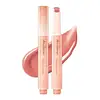What's inside
What's inside
 Key Ingredients
Key Ingredients

 Benefits
Benefits

 Concerns
Concerns

 Ingredients Side-by-side
Ingredients Side-by-side

Hydrogenated Polyisobutene
EmollientDipentaerythrityl Tetrahydroxystearate/Tetraisostearate
Skin ConditioningEthylhexyl Hydroxystearate
EmollientTridecyl Trimellitate
EmollientMethyl Hydrogenated Rosinate
PerfumingPhytosteryl/Isostearyl/Cetyl/Stearyl/Behenyl Dimer Dilinoleate
Skin ConditioningPropylene Glycol Dibenzoate
Skin ConditioningSynthetic Wax
AbrasiveDiisostearyl Malate
EmollientParaffin
PerfumingArgania Spinosa Kernel Oil
EmollientSimmondsia Chinensis Seed Oil
EmollientAcer Saccharum Extract
Skin ConditioningEuterpe Oleracea Fruit Extract
Fragaria Chiloensis Fruit Extract
Skin ConditioningLycium Chinense Fruit Extract
AntioxidantMorus Nigra Fruit Extract
Skin ConditioningRibes Nigrum Fruit Extract
AstringentRubus Fruticosus Fruit Extract
AstringentRubus Idaeus Fruit Extract
AstringentVaccinium Angustifolium Fruit Extract
Skin ProtectingVaccinium Macrocarpon Fruit Extract
AstringentVaccinium Myrtillus Fruit Extract
Skin ConditioningPhytosteryl Macadamiate
Skin ConditioningSilica Silylate
EmollientSorbitan Isostearate
EmulsifyingVp/Hexadecene Copolymer
Dextrin Palmitate
EmulsifyingMicrocrystalline Wax
Emulsion StabilisingPolyglyceryl-2 Triisostearate
EmulsifyingCera Microcristallina
Emulsion StabilisingPolyglyceryl-2 Diisostearate
EmulsifyingWater
Skin ConditioningButylene Glycol
HumectantEthylhexylglycerin
Skin ConditioningPhenoxyethanol
PreservativeCI 77891
Cosmetic ColorantCI 77491
Cosmetic ColorantCI 77492
Cosmetic ColorantCI 15850
Cosmetic ColorantCI 15985
Cosmetic ColorantCI 77499
Cosmetic ColorantHydrogenated Polyisobutene, Dipentaerythrityl Tetrahydroxystearate/Tetraisostearate, Ethylhexyl Hydroxystearate, Tridecyl Trimellitate, Methyl Hydrogenated Rosinate, Phytosteryl/Isostearyl/Cetyl/Stearyl/Behenyl Dimer Dilinoleate, Propylene Glycol Dibenzoate, Synthetic Wax, Diisostearyl Malate, Paraffin, Argania Spinosa Kernel Oil, Simmondsia Chinensis Seed Oil, Acer Saccharum Extract, Euterpe Oleracea Fruit Extract, Fragaria Chiloensis Fruit Extract, Lycium Chinense Fruit Extract, Morus Nigra Fruit Extract, Ribes Nigrum Fruit Extract, Rubus Fruticosus Fruit Extract, Rubus Idaeus Fruit Extract, Vaccinium Angustifolium Fruit Extract, Vaccinium Macrocarpon Fruit Extract, Vaccinium Myrtillus Fruit Extract, Phytosteryl Macadamiate, Silica Silylate, Sorbitan Isostearate, Vp/Hexadecene Copolymer, Dextrin Palmitate, Microcrystalline Wax, Polyglyceryl-2 Triisostearate, Cera Microcristallina, Polyglyceryl-2 Diisostearate, Water, Butylene Glycol, Ethylhexylglycerin, Phenoxyethanol, CI 77891, CI 77491, CI 77492, CI 15850, CI 15985, CI 77499
Diisostearyl Malate
EmollientBis-Diglyceryl Polyacyladipate-2
EmollientBis-Behenyl/Isostearyl/Phytosteryl Dimer Dilinoleyl Dimer Dilinoleate
EmollientPolyglyceryl-2 Triisostearate
EmulsifyingHydrogenated Polyisobutene
EmollientParaffin
PerfumingMicrocrystalline Wax
Emulsion StabilisingSorbitan Isostearate
EmulsifyingCetyl PEG/PPG-10/1 Dimethicone
EmulsifyingTitanium Dioxide
Cosmetic Colorant1,2-Hexanediol
Skin ConditioningParfum
MaskingTocopheryl Acetate
AntioxidantCI 15850
Cosmetic ColorantCI 15985
Cosmetic ColorantCI 77491
Cosmetic ColorantBHT
AntioxidantPentaerythrityl Tetra-Di-T-Butyl Hydroxyhydrocinnamate
AntioxidantDiisostearyl Malate, Bis-Diglyceryl Polyacyladipate-2, Bis-Behenyl/Isostearyl/Phytosteryl Dimer Dilinoleyl Dimer Dilinoleate, Polyglyceryl-2 Triisostearate, Hydrogenated Polyisobutene, Paraffin, Microcrystalline Wax, Sorbitan Isostearate, Cetyl PEG/PPG-10/1 Dimethicone, Titanium Dioxide, 1,2-Hexanediol, Parfum, Tocopheryl Acetate, CI 15850, CI 15985, CI 77491, BHT, Pentaerythrityl Tetra-Di-T-Butyl Hydroxyhydrocinnamate
Ingredients Explained
These ingredients are found in both products.
Ingredients higher up in an ingredient list are typically present in a larger amount.
Ci 15850 is the pigment color red. It is an azo dye and created synthetically.
Azo dyes need to be thoroughly purified before use. This allows them to be more stable and longer-lasting.
This ingredient is common in foundations, lipsticks, and blushes. This color is described as brown/orangey red.
It has many secondary names such as Red 6 and Red 7. According to a manufacturer, Red 6 usually contains aluminum.
Learn more about CI 15850Ci 15985 is a dye made from petroleum. It is synthetically created and approved by the FDA for use in foods and cosmetics.
The color of this dye is orange/yellow.
This ingredient can be found in makeup, sun care, and skincare.
Learn more about CI 15985Ci 77491 is also hydrated iron III oxide. It's sole purpose is to give a red/pink hue to products.
Iron III oxides are classified as inorganic chemicals for coloring.
Synthetically created Ci 77491 is considered safer than those naturally found. This is because the synthetically created version may contain less impurities. Iron oxides are generally non-toxic and non-allergenic.
Learn more about CI 77491Diisostearyl Malate is an emollient and most often used in lip products. It comes from isostearyl alcohol, a fatty acid, and malic acid, an AHA.
As an emollient, Diisostearyl Malate helps create a thin film on your skin to trap moisture in. This helps keep your skin soft and smooth.
Hydrogenated Polyisobutene is a synthetic polymer. Polymers are compounds with high molecular weight. Hydrogenated Polyisobutene is an emollient and texture enhancer.
In one study, Hydrogenated Polyisobutene showed better skin hydration levels than Caprylic/Capric Triglyceride. As an emollient, it helps keep your skin soft and hydrated by trapping moisture in.
Hydrogenated Polyisobutene is often used as a mineral oil replacement.
Learn more about Hydrogenated PolyisobuteneMicrocrystalline Wax is created by de-oiling petroleum. It is highly refined and purified before being added to cosmetics.
Microcrystalline Wax is used to enhance the texture and create even consistency. It helps stabilize a product by preventing ingredients from separating.
Paraffin is a solid created from petroleum. The term 'paraffin' can also refer to either
petroleum jelly or mineral oil.
It has natural occlusive properties which can worsen oily skin. Due to its petrolatum base, this ingredient is not fungal-acne safe.
This ingredient is a form of glycerin with emulsifying and emollient properties.
As an emulsifier, this ingredient helps keep products together while adding a thick texture. The manufacturer states this ingredient has emollient properties. Emollients help keep the skin hydrated by trapping moisture in.
Polyglyceryl-2 Triisostearate is created by reacting diglycerin and isostearic acid. Due to the isostearic acid base, it may not be safe for Malassezia or fungal acne.
Learn more about Polyglyceryl-2 TriisostearateSorbitan Isostearate is an emulsifer and cleaning agent. It is created from isostearic acid and sorbitol.
As an emulsifier, Sorbitan Isostearate prevents oils and water from separating.
Due to its isostearic acid base, it may not be safe for Malassezia or fungal acne.
Learn more about Sorbitan Isostearate